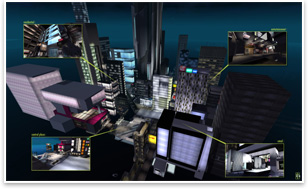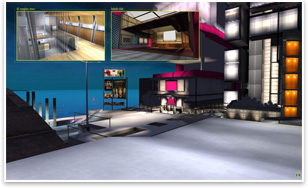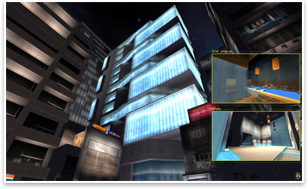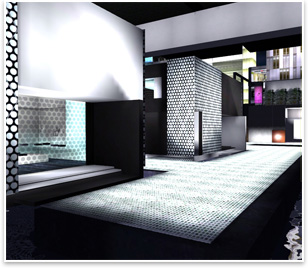|
Fantasy Is Relative: From Real to Virtual and Back Again
Architecture and master plan of the RaiJuku District in vSide
by Chris Lee and Ryu Kawai
ii
 Ed. note: This project encompasses a set of “built” architecture—retail, residential, and social—as well as urban planning for vSide, a social networking site owned and operated by Doppelganger Inc. The work was created, designed, and executed by the multidisciplinary design studio ii, founded by Chris Lee and Ryu Kawai, two designers trained in traditional architecture. Ed. note: This project encompasses a set of “built” architecture—retail, residential, and social—as well as urban planning for vSide, a social networking site owned and operated by Doppelganger Inc. The work was created, designed, and executed by the multidisciplinary design studio ii, founded by Chris Lee and Ryu Kawai, two designers trained in traditional architecture.
 We do not have a bias for/against “virtual” and “real” architecture, as the same fundamental spatial design principles apply to both. With this approach at its core, this fantasy master-planning and architectural design project was conceived and executed for a live, online service targeted for teens and funded by venture capital. It is certainly fantasy architecture in that it would not be “built” with brick and mortar (at least not in its entirety), but it’s very real in that thousands of people currently occupy these spaces to socialize, shop, and live in on a daily basis. We do not have a bias for/against “virtual” and “real” architecture, as the same fundamental spatial design principles apply to both. With this approach at its core, this fantasy master-planning and architectural design project was conceived and executed for a live, online service targeted for teens and funded by venture capital. It is certainly fantasy architecture in that it would not be “built” with brick and mortar (at least not in its entirety), but it’s very real in that thousands of people currently occupy these spaces to socialize, shop, and live in on a daily basis.
Teens across the world make up the majority of the vSide‘s online population, and they are rendered in the product with a cel-shaded “cartoon” look. On the other hand, the architecture within the product is designed and rendered with real world sensibilities—Minimalist-Modern to be specific—and materials. This fantasy architecture grounded in Modernist design tenets and real materials serves as the contrasting backdrop for the entirely surreal cartoon look and feel of the avatars (i.e., the personalized online representation of the product users).
 New use for an old organizing device New use for an old organizing device
RaiJuku is one of the “districts” or micro-cities within vSide’s world of connected areas. Each area offers a unique experience with different cultural and historical references. RaiJuku is based on HaraJuku and ShinJuku areas of Tokyo in its general energetic and youthful vibe, with a bit of Bladerunner futurism sprinkled in. Underlying it all, however, the city’s organization and layout principles are informed by the piazzas/plazas, such as St. Marcos in Venice or Plaza Mayor in Madrid.
Public squares are, of course, one of the great historical success stories in the practice of city planning, and our intent was to encourage social behavior in this virtual city just as much as these older examples did for their citizens centuries before.
 Architecture in RaiJuku at a quick glance is a mixture of the designed, banal, fun, ruined, and even a little sci-fi. Primary functional spaces within it, however, are carefully crafted specifically for their intended programs with a unifying, consistent architectural design philosophy as well as appropriate levels of design details. A lounge is designed to promote social gathering around music, dancing, and “drinking”; a residence is designed to provide a personalized upscale urban living; and a retail boutique is designed to support a good shopping experience for the consumer and properly project its brand. In fact, iiC, a martini-lounge within RaiJuku, is being further detailed and documented with the intention of it being built in “real.” Hence: From real to virtual and back again. Architecture in RaiJuku at a quick glance is a mixture of the designed, banal, fun, ruined, and even a little sci-fi. Primary functional spaces within it, however, are carefully crafted specifically for their intended programs with a unifying, consistent architectural design philosophy as well as appropriate levels of design details. A lounge is designed to promote social gathering around music, dancing, and “drinking”; a residence is designed to provide a personalized upscale urban living; and a retail boutique is designed to support a good shopping experience for the consumer and properly project its brand. In fact, iiC, a martini-lounge within RaiJuku, is being further detailed and documented with the intention of it being built in “real.” Hence: From real to virtual and back again.
 From architecture to the new medium From architecture to the new medium
We are proud of our fantasy design project. We used every bit of what we have learned in our great architecture profession and applied them to a new medium. We hope to have had measurable impact by sharing our appreciation for the inherent benefits of a newly thought out, but historically deferential, set of architectural spaces for a young audience who did not explicitly expect it. We also hope to bring to our profession’s attention that vast opportunities exist in this new virtual medium to reach and serve the public in ways our design discipline has not embraced thus far.
|



